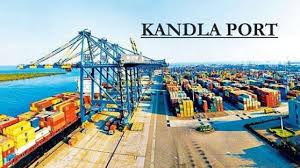India’s state-owned Kandla Port Trust created history by handling 100 million tonnes (mt) of cargo in the year ended March, becoming the first government-run port in India (there are 12 of them) to achieve this feat.
It is only the second Indian port to hit the three-figure mark after privately-run Mundra port, located just 60km away on the Gulf of Kutch. Mundra, India’s biggest commercial port by volume, clocked 100 mt two years ago.
So, what makes Kandla, located in the western state of Gujarat, tick?
At a water depth of 12.5 metres, Kandla can hardly lay claim to be a deep-water port where bigger ships can call. Private firms have largely stayed away from investing money to set up cargo-handling berths through the so-called public-private partnership (PPP) route at the port.
Out of the 10 cargo berths that were given to private firms since India liberalized its ports sector in the late 1990s, only six are operational. Two PPP projects didn’t take off for various reasons. Another two berths that were given to a private firm to handle containers had to be terminated mid-way through a 30-year contract after the company failed to achieve the contractually-mandated minimum volumes for three consecutive years.
Vadinar, the satellite port of Kandla, handled 53 mt of crude oil and petroleum products from three single buoy moorings (SBMs) and two petroleum product export jetties during the year. A single buoy mooring is a floating buoy/jetty anchored offshore to allow handling of liquid cargo such as crude and petroleum products.
Kandla also handled 35 mt of dry bulk cargo and another 12 mt of other oil products, including edible oil, during 2015-16. Adani Ports and Special Economic Zone Ltd (APSEZ), India’s biggest port developer and operator, is playing a part in its improved performance. Of the 35 mt of dry bulk handled by Kandla during the year, 3.7 mt was handled at another satellite facility in Tuna-Tekra run by APSEZ, which runs Mundra port among a network of eight ports across the eastern and western seaboard. The year 2015-16 was the first full year of operations at Tuna-Tekra.
Being a Union government port, Kandla operates under a regulated regime where its rates are set by the Tariff Authority for Major Ports (TAMP), the regulator for the 12 ports controlled by the Union government.
Why are the two 100-mt cargo handling ports in India located in the same state (Gujarat), separated by a mere 60 km? Port experts attribute the success of Kandla and Mundra partly to their strategic location.
About 70% of India’s trade in commodities such as crude oil, coal, fertilizers, foodgrains and container cargo is accounted for by cargo originating and destined for centres in north and north-western India, including the national capital region centred on Delhi apart from Gujarat, Rajasthan, Haryana, Punjab, western Uttar Pradesh and Himachal Pradesh.
The location is also a gateway to Europe, the US, Africa and West Asia.
Many believe it was Mundra’s growing stature that propelled Kandla to pull up its socks and improve its efficiency and productivity.
On an average, a ship now takes less than two-and-a-half days to turn around in Kandla, compared with 18-20 hours in Mundra. The turn-around time for ships—the time taken by a ship from berthing, unloading and departure—was as high as 5.05 days in Kandla a few years ago, including 2.54 days spent just waiting at outer anchorage to get a berth. As a result, there was always a long queue of ships waiting to berth. This was because Kandla was always operating at more than 100% capacity utilization with the resultant congestion and delays.
While ships had to spend more time at Kandla to berth, unload, load cargo and sail off, the extra time and costs arising from this is offset by the low cargo-handling rate at the port.
Kandla, perhaps, has the lowest cargo-handling rates among ports in India. The port is also closer to the hinterland (cargo originating and destination area) by 70 km when compared with its main rival, Mundra. As a result, the land transportation costs for bringing and evacuating cargo to and from the port is lesser for customers of Kandla.
Over the past three years, the total cargo-handling capacity has increased only marginally to 123.21 mt now from 91.22 mt in 2013, resulting in capacity utilization dropping to 82%. So, for the first time in many years, berths were waiting for ships at Kandla throughout the year in 2015-16, instead of ships waiting for berths.
The efficiency and productivity improvement measures taken by the port have started yielding results. For instance, the average output per ship berth day has also increased from 15,091 tonnes in 2012-13 to 16,457 tonnes now.
The port’s six oil jetties now clock a productivity rate of 347 metric tonnes per hour in loading/discharge, compared with 219 metric tonnes per hour last year, an improvement of 59%.
The productivity of the bulk cargo berths have improved by 20% to 14,301 metric tonnes per hour from 11,980 metric tonnes per hour last year.
Container freight is the only missing cargo in Kandla. This aberration is sought to be rectified by the port management by awarding a 30-year contract for two berths laying vacant since 2012 to private firm United Liner Agencies of India (Pvt. ) Ltd for container handling. This will make Kandla a much more diversified, multi-cargo port.






